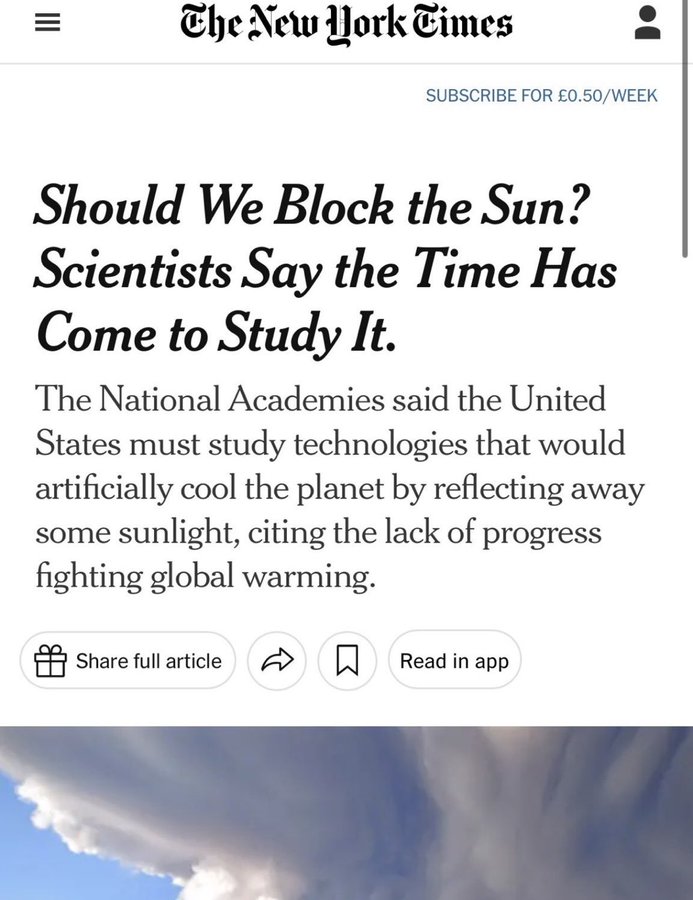
As climate change continues to threaten our planet, scientists and policymakers are exploring increasingly drastic measures to combat rising temperatures. One such proposal, known as solar geoengineering, aims to artificially cool the Earth by reflecting sunlight back into space (i.e. blocking the sun). However, this controversial approach carries profound risks that could jeopardize the very foundation of life on our planet.
The sun, our celestial life-giver, is essential for all earthly organisms. It drives our weather patterns, powers photosynthesis, and regulates our circadian rhythms.


Yet, in a desperate bid to mitigate climate change, some researchers are proposing to tinker with this delicate balance by essentially “dimming the sun.”
The National Academies of Sciences, Engineering, and Medicine recently recommended that the U.S. government invest at least $100 million in solar geoengineering research. Chris Field, director of the Woods Institute for the Environment at Stanford University, stated, “Solar geoengineering is not a substitute for decarbonizing. Still, it deserves substantial funding, and it should be researched as rapidly and effectively as possible.”
Simultaneously, the European Union is joining international efforts to assess large-scale climate interventions. A draft document seen by Bloomberg reveals that the EU “will support international efforts to assess comprehensively the risks and uncertainties of climate interventions, including solar radiation modification.”
While these initiatives may seem progressive, they open a Pandora’s box of potential catastrophes.
One proposed method, stratospheric aerosol injection, involves releasing reflective particles high into the atmosphere. This technique aims to mimic the cooling effect of volcanic eruptions.

Professor Jim Haywood, an atmospheric scientist at the University of Exeter, urges caution: “I really want to know about the detrimental impacts of climate change, but also about the potential side-effects and detrimental impacts of any solar radiation management deployments.”
Indeed, the risks are manifold. Computer models suggest that solar geoengineering could dramatically alter global weather patterns, potentially causing severe droughts in some regions while flooding others. The Amazon rainforest, often called the “lungs of the planet,” could face devastating consequences.
Haywood explains, “Brightening the cloud off the coast of Namibia could induce drought over South America and particularly Brazil. What’s in Brazil? Well, the rainforests.”
Professor Liz Bentley, chief executive of the Royal Meteorological Society, adds, “The regional impacts are very much unknown. We may be able to mitigate global average temperature [rise], but we may actually make things worse in certain regions of the world.”
Moreover, the abrupt cessation of such interventions could lead to rapid, catastrophic warming.
This scenario could push ecosystems past their tipping points, resulting in mass extinctions and irreversible damage to our biosphere. As the EU document warns, “These technologies introduce new risks to people and ecosystems, while they could also increase power imbalances between nations, spark conflicts and raises a myriad of ethical, legal, governance and political issues.”
The proposed technologies also raise serious ethical and geopolitical concerns. The potential for unilateral action by powerful nations or even wealthy individuals is a chilling prospect that could destabilize international relations.
One company in the US has already started selling ‘cooling credits’, promising to send balloons filled with sulphur dioxide into the stratosphere for a fee.
Further complicating matters is the rise of conspiracy theories surrounding geoengineering. Researchers from the University of Cambridge found that such theories are hampering legitimate scientific inquiry. Dr. Ramit Debnath, an assistant professor at the University of Cambridge, reports, “
A lot of funders are very sceptical of funding research” because they are wary of being targeted by conspiracists. His analysis of almost 2 million tweets with the hashtag #GeoEngineering found that over 70% expressed negative sentiments about solar radiation management, with the majority tapping into conspiracies.
Perhaps most alarmingly, the pursuit of solar geoengineering threatens to divert attention and resources from the crucial task of reducing greenhouse gas emissions.
In 2022, hundreds of scientists signed an open letter calling for a global non-use agreement on solar radiation management, warning that increasing calls for development provided “cause for concern” with the dangers involved “poorly understood” and something that would act as a disincentive to governments, businesses and societies from decarbonizing.
As we stand on the precipice of potentially altering our planet’s fundamental processes, we must ask ourselves: Is the cure worse than the disease?
The sun has nurtured life on Earth for billions of years. Tampering with its influence on our planet is a gamble of unprecedented proportions.
Michael Gerrard, director of the Sabin Center for Climate Change Law at Columbia Law School, suggests that the very prospect of geoengineering might serve as a wake-up call: “It could be so scary that people will be even more motivated to reduce emissions.”
Instead of reaching for quick fixes that could irreparably damage our world, we must redouble our efforts to address the root cause of climate change.
RELATED: Trees are Nature’s Champions in the Fight Against Climate Change
Reducing emissions, transitioning to renewable energy, and protecting our natural ecosystems are proven strategies that don’t risk the very foundations of life on Earth.
In our quest to cool our warming planet, we must not lose sight of the sun’s irreplaceable role in sustaining all life. The dangers of solar geoengineering serve as a stark reminder that sometimes, the most powerful solution is to work with nature, not against it.
As Professor Bentley wisely notes, “It isn’t a silver bullet that’s going to solve everything. But it possibly could be part of an array of solutions.”
The key lies in finding the right balance between innovation and caution, always keeping in mind the profound responsibility we bear for the future of our planet and all its inhabitants.
References:
Conspiracy theories swirl about geo-engineering, but could it help save the planet? BBC, 21 July 2024
EU Looks Into Blocking Out the Sun as Climate Efforts Falter, Bloomberg, June 26, 2023 (non-paywall link)
Should We Block the Sun? Scientists Say the Time Has Come to Study It, NY Times, March 28 2012 (non-paywall link)
Conspiracy theories about geoengineering are harming research, scientists claim, independent.co.uk, 28 February 2023
RELATED: Earth’s Decreasing Albedo, Not CO2, May Be the Real Culprit Behind Climate Change







